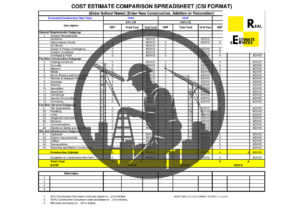The CSI (Construction Specifications Institute) format Cost Estimate is a standardized method for organizing construction documents. It streamlines the estimating process and ensures consistency across projects. Understanding the CSI format is essential for creating accurate cost estimates, as it is widely used in the construction industry.
What is a CSI Format Cost Estimate?
A CSI format cost estimate organizes project costs into divisions based on the MasterFormat system. This system includes 50 divisions, each representing a different aspect of construction, such as site work, concrete, masonry, finishes, and electrical. By categorizing costs in this way, estimators can provide a detailed breakdown of expenses, making it easier to track and manage budgets.

Importance of Using CSI Format
Using the CSI format in cost estimation has several advantages. It provides a standardized approach that the construction industry recognizes and accepts. This standardization ensures that all parties involved in the project—architects, contractors, and clients—are on the same page regarding costs. Moreover, the CSI format allows for easy comparison of estimates from different projects or bidders, facilitating more informed decision-making.
Steps to Create a CSI Format Cost Estimate
Creating a CSI format cost estimate involves several steps. Here’s how to approach it:
1. Understand the Project Scope
Before starting the estimate, it’s crucial to understand the full scope of the project. Review architectural plans, specifications, and other relevant documents to account for all aspects of the project.
2. Organize Costs by CSI Divisions
Next, categorize the project costs according to the appropriate CSI divisions. For example, if your project involves masonry work, you would place these costs under Division 04 – Masonry. Continue reviewing each project aspect, placing every cost in the correct division.
3. Break Down Costs into Line Items
Within each division, further break down the costs into individual line items. For instance, under Division 09 – Finishes, you might have separate line items for painting, flooring, and drywall installation. This level of detail allows for more precise cost tracking and adjustments.
4. Apply Unit Costs
Establish the line items and then apply the appropriate unit costs. This involves calculating the cost per unit of measurement (e.g., per square foot, per cubic yard) for each line item. Source unit costs from historical data, industry standards, or cost databases.
5. Summarize and Review the Estimate
Summarize the estimate by totaling the costs in each division after inputting all costs. Review the estimate to ensure accuracy and completeness. Double-check all project elements to ensure inclusion and confirm that the costs are realistic.
Advantages of CSI Format Cost Estimating
The CSI format offers several benefits to construction professionals. It promotes transparency by providing a clear, organized breakdown of project costs. It also facilitates communication between different stakeholders by using a common language and structure. Additionally, the CSI format supports better project management by allowing for easier tracking of costs against the budget as the project progresses.
Common Challenges in CSI Format Cost Estimating
While the CSI format is highly effective, it is not without challenges. One common issue is ensuring that all relevant costs are captured, especially in complex projects with multiple divisions. Another challenge is accurately applying unit costs, which can vary based on location, market conditions, and project specifics. Overcoming these challenges requires careful attention to detail and ongoing communication with project stakeholders.
Conclusion
The CSI format cost estimate is a vital tool in the construction industry, offering a structured, standardized approach to estimating project costs. By understanding and utilizing this format, construction professionals can enhance the accuracy of their estimates, improve project management, and facilitate better communication with stakeholders. As you move forward with your projects, consider adopting the CSI format to streamline your estimating process and achieve more reliable results.

